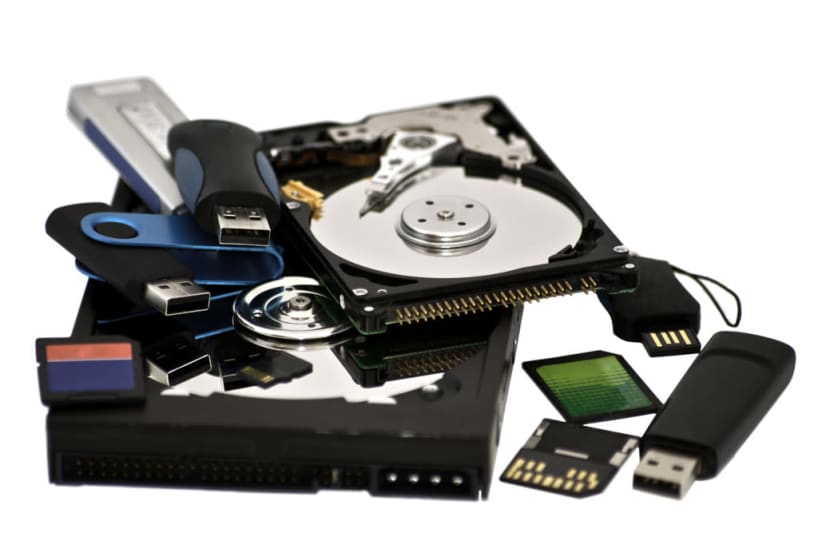Although external hard drives are often used in modern computing, and some even pair third-party hard drive enclosures with drives from well-known manufacturers, the process of recovering lost data is the same across the board. If your external hard drive enclosure uses a traditional hard disk drive, you'll be able to use many of the same methods and software as you would when working with a standard hard drive that is already installed inside of a PC. The same goes with solid-state drives.
Hard Disk Drives
Traditional hard disk drives (HDDs) have more options available than any other drives. However, depending on the severity of the problem, it might be impossible to perform a successful recovery. If you've recently experienced a hard disk failure, or if the hard drive is currently inaccessible, start by connecting the hard drive to another system.
Avoid using the affected hard drive during this time, as doing so could cause even more damage. However, it's always a good idea to test it on another system to ensure that the problem is with the hard drive itself.
If it's still inaccessible on your secondary system, there are a myriad of software-based tools at your disposal. Many of them are free, but these often feature limited functionality. Depending on how much you value your data, it might be worthwhile to spend a few dollars on a professional solution.
According to recent tests, R-STUDIO ranks as one of the most reliable data recovery software solutions available today. It's also well-known and widely used amongst professional data forensics specialists around the world.
In fact, after testing no less than six different data recovery software packages for Windows, R-STUDIO consistently shows the best results. Not only does it have a plethora of complementary features, like an integrated hexadecimal editor, S.M.A.R.T. attribute monitoring, and more, but it also includes built-in support for data recovery from RAID and logical disks. It's a highly versatile and comprehensive tool that can help you recover data in a variety of scenarios. Moreover, it can be used with both traditional HDDs and solid-state drives.
Solid-State Drives
Solid-state drives, or SSDs, are generally more complicated than common HDDs. In fact, SSDs that have the TRIM option enabled will render all data recovery attempts null and void. As a result, your only choice for a successful data recovery is to restore your data from a previous backup.
If your SSD does not have TRIM enabled, you might be able to perform a successful data recovery with modern software. Once again, there are free and paid solutions available – but there aren't nearly as many options as there are for traditional HDDs.
However, it's important to note that SSD users tend to experience far fewer problems than users of traditional HDDs. According to some estimates, SSDs are replaced 25% less often than modern HDDs. Although most of today's SSDs are expected to last for approximately 10 years, there are a number of factors that can affect their overall lifespan; including the number of data writes per day (DWPD) and the number of terabytes written over time (TBW).
USB Flash Drives
Since USB flash drives use much of the same technology as modern SSDs, data recovery can be incredibly difficult. While there are many software solutions that are compatible with USB flash drives, a successful data recovery is never guaranteed. This makes USB flash drives an ineffective solution for long-term data storage.
Another setback is their relatively short lifespan. While they are comparable to SSDs in terms of functionality, modern SSDs generally have an expected lifespan of approximately 10 years. Although it's not uncommon for a USB flash drive to last this long, they typically fail because of the number of write cycles as opposed to age. With that in mind, most USB flash drives rarely make it to 10 years.
RAID Drives
In theory, RAID architecture includes redundancy measures that minimize the risk of data loss and, as a result, eliminate the need for data recovery. However, this depends on the exact RAID configuration you are using in your system. RAID 0, for example, doesn't provide any sort of data redundancy at all and, as a result, could end up causing permanent data loss.
However, RAID 0 is the only configuration that doesn't support data recovery. Since it involves writing data across multiple disks, you would need full access to every disk in the array in order to perform a successful data recovery. Instead, it's typically used when trying to boost a server's performance.
With other configurations, like RAID 1, data recovery is facilitated through the use of data mirroring. If you're interested in using RAID as a means of data protection, it's best to go with RAID 1 or higher. RAID 2 and 3 are rarely used today, but RAID 5 is often seen on business servers and enterprise-grade NAS devices.
NAS Drives
Network-attached storage (NAS) devices are becoming more commonplace in both enterprise and home settings. As these feature multiple hard drives within a single enclosure, it can be difficult to identify the failed disk.
In this case, you'll need to remove each drive from the NAS and connect it directly to your computer. This process of elimination lets you narrow it down until you finally find the failed drive, at which point you can begin the data recovery process.
DIY Data Recovery
As you can see, each separate storage device requires a unique approach. Moreover, there are different file formats, such as FAT, FAT32, and NTFS, that can introduce additional complications to the data recovery process. Not only do you need to understand the hardware in question, but you need to make sure that your data recovery solution is compatible with your system.
